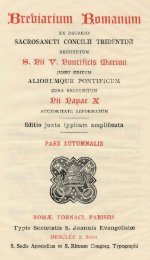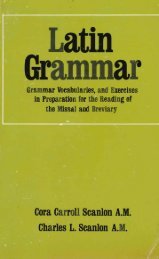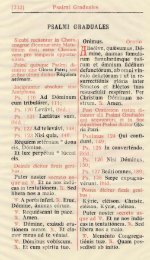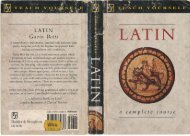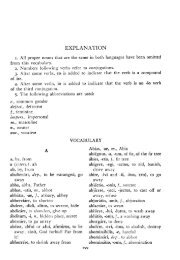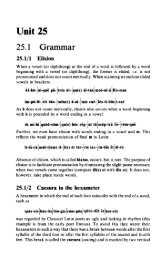- Page 7 and 8:
THEPRINCIPLESOFLATIN GRAMMARCOMPRIS
- Page 9 and 10:
PREFACE.In the study of any languag
- Page 11 and 12:
...INDEX.A.PAGEA 1 lative, meaning
- Page 13 and 14:
...CINDEX.VIIPAGE Pronouns,pageMcod
- Page 15 and 16:
—;LATIN GEAMMAR.1. Late* Geammae,
- Page 17 and 18:
—§ 1 LETTERS. 3a consonant. The
- Page 19 and 20:
§ 3 SYLLABLES. 5lowed by a consona
- Page 21 and 22:
;§ 3 SYLLABLES. 723.— Accent is
- Page 23 and 24:
;§ 5, 6 PARTS OF SPEECH.—OF THE
- Page 25 and 26:
§ 7 ACCIDENTS OF THE NOUN. 1139.
- Page 27 and 28:
—§ 8 DECLENSION. 135. The Vocati
- Page 29 and 30:
§9 FIRST DECLENSION. 1560.—The f
- Page 31 and 32:
—§ 10 SECOND DECLENSION. 17Like
- Page 33 and 34:
:§10 SECOND DECLENSION. 19Regnum,
- Page 35 and 36:
—:§ 10 THIRD DECLENSION. 21GREEK
- Page 37 and 38:
12 THIRD DECLENSION. 285. In the fo
- Page 39 and 40:
—:& 12 THIKD DECLENSION. 2582.—
- Page 41 and 42:
—§ 13 THIRD DECLENSION. 27§ 13.
- Page 43 and 44:
—:§ 13 THIRD DECLENSION. 296. Ex
- Page 45 and 46:
§ 15 THIRD DECLENSION. SIABLATIVE
- Page 47 and 48:
§ 16 FOURTH DECLENSION. 33Bos, an
- Page 49 and 50:
:§ 16 FOURTH DECLENSION. 35Exc. 3.
- Page 51 and 52:
:;§17 FIFTH DECLENSION. 372. Facie
- Page 53 and 54:
—;;§ IS IRREGULAR NOUNS. 394. Ne
- Page 55 and 56:
;§ 18 IRREGULAR NOUNS. 41Ablative.
- Page 57 and 58:
—:::§ 18 IKKEGULAR NOUNS. 43the
- Page 59 and 60:
•:§ 18 IRREGULAR NOUNS. 45are pr
- Page 61 and 62:
§ 18 IRREGULAR NOUNS. 47SuffImen,
- Page 63 and 64:
—.§ 20 ADJECTIVES. 49§ 20. ADJE
- Page 65 and 66:
—§ 21 ADJECTIVES. 51Note 2. Aliu
- Page 67 and 68:
—:§21 ADJECTIVES. 53JExc. Plus,
- Page 69 and 70:
.§ 22 ADJECTIVES. 55Primoris, geni
- Page 71 and 72:
.:§ 24 NUMERAL ADJECTIVES. 57§ 24
- Page 73 and 74:
§ 24 NUMEKAL ADJECTIVES. 59Duo, tw
- Page 75 and 76:
§ 24 NUMERAL ADJECTIVES. 61Ordinal
- Page 77 and 78:
§ 25 COMPARISON OF ADJECTIVES. 631
- Page 79 and 80:
§;;;§26 COMPARISON OF ADJECTIVES.
- Page 81 and 82:
;§ 27 DERIVATION OF ADJECTIVES. 67
- Page 83 and 84:
§ 28 PRONOUNS.Tu, thou, Second Per
- Page 85 and 86:
:§ *28 pboxouxs. 71cerunt, " his f
- Page 87 and 88:
:;§ 30 POSSESSIVE PRONOUNS. 73and
- Page 89 and 90:
98,§ 31 DEMONSTRATIVE PRONOUNS. 75
- Page 91 and 92:
§ 33 RELATIVE PRONOUN. 77rendered
- Page 93 and 94:
—§ 34 INTERROGATIVE PRONOUN. 79P
- Page 95 and 96:
§ 37 COMPOUND PRONOUNS. 81Quicunqu
- Page 97 and 98:
§ 38 THE VERB. 83Obs. 2. Some of t
- Page 99 and 100:
§ 39 THE VERB. 85§ 39. DIFFERENT
- Page 101 and 102:
.—§ 41 THE VERR— VOICE. 87the
- Page 103 and 104:
§ 42 THE VERB.— MOODS. 891st. It
- Page 105 and 106:
——§ 43 THE VERB.— TENSES. 91
- Page 107 and 108:
§ 44 THE VERB.—TENSES. 93English
- Page 109 and 110:
;§ 44 THE VERB.—TENSES. 95true a
- Page 111 and 112:
;§ 45 THE VERB.—TENSES. 97170
- Page 113 and 114:
———§ 45 THE VEKB.—TENSES.
- Page 115 and 116:
——;§ 47 THE VERB.—TENSES. 10
- Page 117 and 118:
5—§ 47 THE VERB.—TENSES. 103th
- Page 119 and 120:
—.•§ 48 THE VEKB.—TENSES. 10
- Page 121 and 122:
*;§ 49 THE VERB.—PARTICIPLES. 10
- Page 123 and 124:
:;51 THE V r EEB.—CONJUGATION. 10
- Page 125 and 126:
—;§ 52 THE VERB.—FORMATION OF
- Page 127 and 128:
;§ 53 THE VERB.—FORMATION OF TEN
- Page 129 and 130:
§ 54 THE VERB.—SUM. 115Imperfect
- Page 131 and 132:
—§ 55 THE VERB.—SUM. 117INFINI
- Page 133 and 134:
.§ 56 THE VEKB.—FIRST CONJUGATIO
- Page 135 and 136:
;§56 THE 7ERB.—FIRST CONJUGATION
- Page 137 and 138:
—:——§ 57 THE VERB.—FIRST C
- Page 139 and 140:
§ 58 THE VERB.—FIRST CONJUGATION
- Page 141 and 142:
—§ 59 THE VEEB.—FIEST CONJUGAT
- Page 143 and 144:
;J§ 60 THE VERB.—SECOND CONJUGAT
- Page 145 and 146:
. With,I§ 61 THE VERB.—SECOND CO
- Page 147 and 148:
;§ 62 THE VEKB.—SECOND CONJUGATI
- Page 149 and 150:
:§ 63 THE VERB.—SECOND CONJUGATI
- Page 151 and 152:
Ye§ 64 THE VERB.—THIRD CONJUGATI
- Page 153 and 154:
i;:§.64 THE VERB.—THIRD CONJUGAT
- Page 155 and 156:
—;—§ 66 THE VERB.—THIRD CONJ
- Page 157 and 158:
They;;\§ 66 THE VERB.—THIRD CONJ
- Page 159 and 160:
—67 THE VEKB.— THIRD CONJUGATIO
- Page 161 and 162:
;§ 68 THE VERB.—FOURTH CONJUGATI
- Page 163 and 164:
.§ 80 COMPOUND VERBS. 1G5§ 80. CO
- Page 165 and 166:
.: 'have§ 81 PERFECTS AND SUPINES.
- Page 167 and 168:
;§ 81 PERFECTS AND SUPINES. 169The
- Page 169 and 170:
:§ 81 PERFECTS AND SUPINES. 171Pre
- Page 171 and 172:
;§81 PERFECTS AND SUPINES. 173Pres
- Page 173 and 174:
§81 PEEFECTS AND SUPINES. 175Pres.
- Page 175 and 176:
'§81 PERFECTS AND SUPINES. 177Pres
- Page 177 and 178:
§81 PEEFECTS AND SUPINES. 179Pres.
- Page 179 and 180:
—;:;:§ 83 IRREGULAR VERBS. 181Na
- Page 181 and 182:
;;;§ 83 IRREGULAR VERBS. 1833. Eo,
- Page 183 and 184:
;;;;83 IRREGULAR VERBS. 185SUBJUNCT
- Page 185 and 186:
;§ 83 IRREGULAR VERBS. 187In like
- Page 187 and 188:
— — —; —§ 84 DEFECTIVE VER
- Page 189 and 190:
§85 IMPERSONAL VERBS. 1912. Impers
- Page 191 and 192:
;§ 86 IMPEKSOXAL VERBS. 193224,—
- Page 193 and 194:
;;;;§ 88 DERIVATIVE VERBS. 195227.
- Page 195 and 196:
:then;§ 89 ADVERBS. 1974th. JIono?
- Page 197 and 198:
.,:§ 90 PREPOSITIONS. 199Positive
- Page 199 and 200:
§ 91 PREPOSITIONS IN COMPOSITION.
- Page 201 and 202:
§ 93 conjunctions. 203§ 93. CONJU
- Page 203 and 204:
——§ 95 syntax. 20c244.—§ 95
- Page 205 and 206:
§ 96, 97 SYNTAX.—SUBSTANTIVE. 20
- Page 207 and 208:
——Bonarum§ 98 SYNTAX.—ADJECT
- Page 209 and 210:
—,§ 98 SYNTAX.—ADJECTIVE. 2112
- Page 211 and 212:
———;SYNTAX.—RELATIVE. 2 J 3
- Page 213 and 214: ———;:—§ 99 SYNTAX.—RELAT
- Page 215 and 216: ——;§ 100, 101 SYNTAX.—NOMINA
- Page 217 and 218: ——§ 102 SYNTAX.—OBSERVATIONS
- Page 219 and 220: —§104 SYNTAX.—GOVERNMENT. 221t
- Page 221 and 222: ——§ 106 SYNTAX.—GENITIVE. 22
- Page 223 and 224: ——:——;§ 107 SYNTAX.—GENI
- Page 225 and 226: ——v.ter§ 107 SYNTAX.— GENITI
- Page 227 and 228: ——§ 108 SYNTAX.—GENITIVE. 22
- Page 229 and 230: ——§ 110, 111 SYNTAX.—DATIVE.
- Page 231 and 232: ——:§ 112 SYNTAX.—DATIVE. 233
- Page 233 and 234: § 112 SYNTAX.—DATIVE. 2355. Intc
- Page 235 and 236: —:P§ 113 SYNTAX.—DATIYE. 23741
- Page 237 and 238: —'.;§ 114 SYNTAX.—DATIVE. 239g
- Page 239 and 240: ——§ 116 SYNTAX.—ACCUSATIVE.
- Page 241 and 242: ——§118 SYNTAX- -ABLATIVE. 2434
- Page 243 and 244: —;§ 120 SYNTAX.—ABLATIVE. 245c
- Page 245 and 246: —————§ 122 SYNTAX.—ACC
- Page 247 and 248: —§ 123 SYNTAX.- -ACCUSATIVE AND
- Page 249 and 250: ——;;§ 125 SYNTAX—ACCUSATIVE
- Page 251 and 252: ——"he§ 126 SYNTAX.—PASSIVE V
- Page 253 and 254: —§ 129 SYNTAX.—CIRCUMSTANCES.
- Page 255 and 256: ——§ 130 SYNTAX.—CIRCUMSTANCE
- Page 257 and 258: ——§ 132 SYNTAX.— CIRCUMSTANC
- Page 259 and 260: ——;§ 134 SYNTAX.—ADVERBS. 26
- Page 261 and 262: —§ 136 SYNTAX—PKEPOSITIONS. 26
- Page 263: ——)§ 137 SYNTAX OF THE VERB.
- Page 267 and 268: ;—;g 1-JtO SYNTAX,—MOODS. 269EX
- Page 269 and 270: —§ 141 SYNTAX.—MOODS. 271an in
- Page 271 and 272: ———§ 141 SYNTAX.—MOODS. 27
- Page 273 and 274: §142-3 SYNTAX.—MOODS. 275.its pa
- Page 275 and 276: ——;;§ 144 SYNTAX.—MOODS. 277
- Page 277 and 278: ——§ 145 SYNTAX.—MOODS. 279on
- Page 279 and 280: —§ 145 SYNTAX.—MOODS. 2811st.
- Page 281 and 282: ———'§ 146 SYNTAX.—THE CASE
- Page 283 and 284: § 147 SYNTAX.—GERUNDS. 285the ve
- Page 285 and 286: ——§ 148 % SYNTAX.—SUPINES. 2
- Page 287 and 288: ——§149 SYNTAX.—CONJUNCTIONS.
- Page 289 and 290: ——§ 151 SYNTAX.—LATIN ARRANG
- Page 291 and 292: —;;§ 151 SYNTAX.—LATIN ARRANGE
- Page 293 and 294: —;—§ 152 SYNTAX.—ANALYSIS. 2
- Page 295 and 296: § 152 SYNTAX.—ANALYSIS. 297or pr
- Page 297 and 298: ——§ 152 SYNTAXanalysis!29SThe
- Page 299 and 300: —::———;§ 153 SYNTAX.—ANA
- Page 301 and 302: § 153 SYNTAX.—PARSING. 303ad Pre
- Page 303 and 304: —§ 155 PROSODY.—QUANTITY. 30O3
- Page 305 and 306: ————§ 157 PROSODY.—QUANT
- Page 307 and 308: ————;§ 158 PROSODY.—QUAN
- Page 309 and 310: ;§ 159 PKOSODY.—QUANTITY. 3115.
- Page 311 and 312: —g 160 PROSODY.—QUANTITY. 313Ru
- Page 313 and 314: —§161 PROSODY.—QUANTITY. 315si
- Page 315 and 316:
———§ 162 PROSODY.—VERSIFIC
- Page 317 and 318:
§163 PROSODY.—METRE. 3196. Those
- Page 319 and 320:
:;|:§ 164 PROSODY.—METRE. 321THE
- Page 321 and 322:
dantenabrachiatollunt.—§ 164 POS
- Page 323 and 324:
nasJanenasPyrrhadiveantra|quernCypr
- Page 325 and 326:
an:emen-Inform,'mantnesnoresam|gens
- Page 327 and 328:
BacchumjCum§169 PROSODY.—METRE.
- Page 329 and 330:
:;331APPENDIX.1. ROMAN COMPUTATION
- Page 331 and 332:
——:—ROMAN COMPUTATION OF TIME
- Page 333 and 334:
:—:DIVISIONS OF THE ROMAN PEOPLE.
- Page 335 and 336:
———ROMAN MONEY—WEIGHTS—AN
- Page 337 and 338:
.KOMAN MONEY—WEIGHTS AND MEASURES
- Page 339 and 340:
:APPENDIX. 341ENGLISH PRONUNCIATION
- Page 341 and 342:
:;APPENDIX. 3433. A single consonan
- Page 343 and 344:
TEXT BOOKSFOR SCHOOLS AND COLLEGES,
- Page 345 and 346:
:;:Farmer, Brace 4- Co's Publicatio
- Page 347 and 348:
Farmer, Brace
- Page 349 and 350:
:Farmer, Brace
- Page 354:
a\-> t^^ v>Deacidified using the Bo



